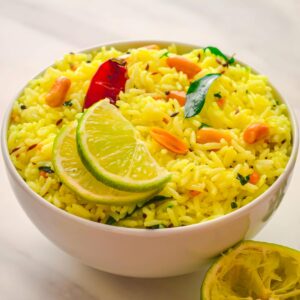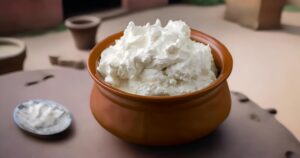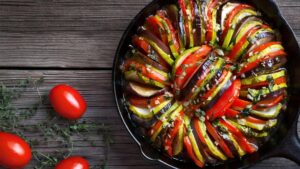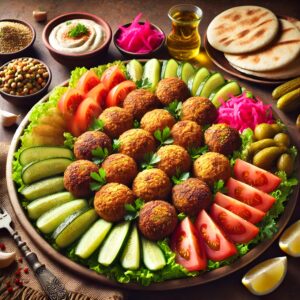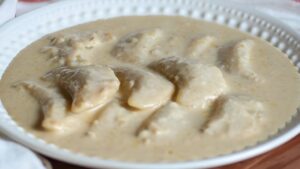Traditional Puran Poli Recipe – Home style
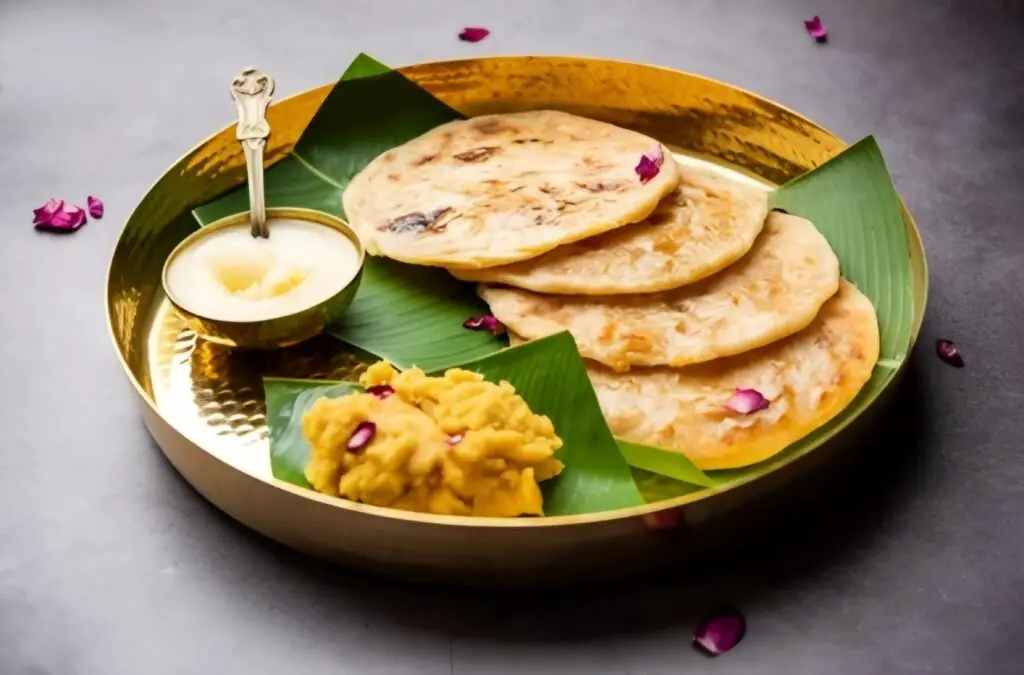
Puran Poli is a traditional Indian sweet flatbread that holds a special place in the cuisine of Maharashtra and other parts of India. It is often prepared during festivals like Holi, Diwali, and special occasions. The bread is stuffed with a sweet filling made from chana dal (split Bengal gram), jaggery, and flavored with cardamom, nutmeg, and saffron. The recipe, although simple, requires a bit of time and patience to perfect. Here’s a detailed recipe for making Puran Poli that will guide you through each step.
Ingredients
For the Dough (Poli)
- Whole wheat flour (Atta): 2 cups
- All-purpose flour (Maida): 1 cup (optional for softness)
- Turmeric powder: 1/4 teaspoon (optional, for color)
- Salt: A pinch
- Oil or Ghee (clarified butter): 2 tablespoons
- Water: As needed to knead the dough
- For the Filling (Puran)
- Chana Dal (split Bengal gram): 1 cup
- Jaggery: 1 to 1.5 cups (adjust sweetness to taste)
- Cardamom powder: 1/2 teaspoon
- Nutmeg powder: 1/4 teaspoon (optional)
- Saffron strands: A pinch (optional, for flavor and color)
- Ghee (clarified butter): 1 tablespoon
For Rolling
Rice flour or whole wheat flour: For dusting
Step-by-Step Instructions
-
Preparing the Dough (Poli)
Mixing the Flours: In a large mixing bowl, combine the whole wheat flour, all-purpose flour (if using), turmeric powder, and a pinch of salt. The turmeric powder gives the dough a slightly yellow hue, which is traditional for Puran Poli.
Adding Oil/Ghee: Add 2 tablespoons of oil or melted ghee to the flour mixture. This makes the dough soft and pliable, resulting in a better texture for the Puran Poli.
Kneading the Dough: Gradually add water and knead the dough until it is smooth and elastic. The dough should not be too soft or too hard, but just the right consistency similar to regular chapati dough. Once kneaded, cover the dough with a damp cloth and let it rest for at least 30 minutes. This resting time allows the dough to become more pliable, making it easier to roll out later.
-
Preparing the Filling (Puran)
Cooking the Chana Dal: Rinse the chana dal thoroughly under running water and soak it in water for about 30 minutes. This reduces the cooking time. After soaking, drain the water and add the dal to a pressure cooker. Add enough water to cover the dal and cook for 3-4 whistles on medium heat until the dal is soft but not mushy. It should hold its shape but be easily mashable.
Draining the Dal: Once the dal is cooked, drain it using a colander, ensuring that all the water is removed. Excess moisture in the dal will make the filling too soft and difficult to handle.
Mashing the Dal: Transfer the drained dal to a large bowl and mash it using a potato masher or the back of a spoon. The dal should be smooth, without any whole pieces.
Cooking the Filling: In a heavy-bottomed pan, add the mashed dal and the jaggery. Cook on low heat, stirring constantly, until the jaggery melts and blends with the dal. Continue cooking until the mixture thickens and starts to leave the sides of the pan. This process can take 10-15 minutes.
Adding Spices: Once the mixture has thickened, add the cardamom powder, nutmeg powder, and saffron strands (if using). Stir well to combine and cook for another 2-3 minutes. The filling should be smooth, thick, and fragrant.
Cooling the Filling: Remove the filling from the heat and let it cool completely. Once cooled, divide the filling into small lemon-sized balls. This will make it easier to stuff the dough later.
-
Assembling the Puran Poli
Dividing the Dough: After the dough has rested, divide it into equal-sized balls, slightly larger than the filling balls.
Rolling the Dough: Take one dough ball and flatten it slightly with your hands. Dust the rolling surface with a little rice flour or whole wheat flour to prevent sticking. Roll the dough ball into a small disc, about 4-5 inches in diameter.
Stuffing the Dough: Place a filling ball in the center of the rolled-out dough. Gather the edges of the dough and bring them together to seal the filling inside. Pinch off any excess dough at the top.
Rolling the Stuffed Dough: Gently flatten the stuffed dough ball and start rolling it out into a larger disc, about 6-8 inches in diameter. Be gentle while rolling to prevent the filling from oozing out. If the filling does start to come out, dust it with some flour and continue rolling.
-
Cooking the Puran Poli
Preheating the Tawa/Griddle: Heat a tawa or griddle on medium heat. It should be hot enough that when you sprinkle some water on it, it sizzles and evaporates immediately.
Cooking the Poli: Place the rolled-out Puran Poli on the hot tawa. Cook for about 30 seconds, or until you see bubbles forming on the surface. Flip the Puran Poli and apply a little ghee on the cooked side.
Flipping and Cooking: Flip the Puran Poli again and apply ghee on the other side. Press lightly with a spatula and cook until both sides are golden brown and have brown spots. Ensure the Puran Poli is cooked evenly on both sides.
Serving: Remove the cooked Puran Poli from the tawa and place it on a plate. Repeat the process with the remaining dough and filling. Serve the Puran Poli hot, topped with a little extra ghee if desired.
Tips for Perfect Puran Poli
Consistency of Dough and Filling: The dough should be soft and pliable, while the filling should be thick and smooth. This ensures that the Puran Poli rolls out easily without tearing.
Even Rolling: Roll the Puran Poli gently and evenly to avoid the filling from breaking through the dough. Dust with flour as needed to prevent sticking.
Cooking on Medium Heat: Cook the Puran Poli on medium heat to ensure it is cooked through without burning the outside. High heat may cause the Puran Poli to remain uncooked inside while the outside turns too dark.
Serving Suggestions
Puran Poli is traditionally served with a dollop of ghee on top, which enhances its flavor and richness. It can be enjoyed with a side of milk, yogurt, or even Aamras (mango puree) during the mango season. In some regions, Puran Poli is served with Katachi Amti, a thin, spicy dal made from the water drained after cooking the chana dal. This combination of sweet and spicy flavors is a unique culinary experience.
Variations
Coconut Puran Poli: Some variations of Puran Poli include adding freshly grated coconut to the filling, which adds a rich texture and flavor.
Multi-grain Puran Poli: For a healthier version, you can replace the all-purpose flour with multi-grain flour or add oats flour to the dough.
Vegan Puran Poli: Substitute ghee with coconut oil or any other vegetable oil to make a vegan version of Puran Poli.
Storing Puran Poli
Puran Poli can be stored in an airtight container at room temperature for a day or two. For longer storage, keep them in the refrigerator for up to a week. Reheat on a tawa or in a microwave before serving.
Conclusion
Puran Poli is not just a dish; it’s a celebration of flavors, tradition, and love. The time and effort put into making Puran Poli are well worth the result—a soft, flavorful flatbread with a sweet, spiced filling that is sure to bring joy to anyone who tastes it. Whether you’re making it for a festival, a special occasion, or just to enjoy with your family, Puran Poli is a treat that brings warmth and sweetness to the table
Here are 10 frequently asked questions (FAQs) based on the Puran Poli recipe:
- Can I use only whole wheat flour for the dough, or do I need to add all-purpose flour?
Yes, you can use only whole wheat flour for a healthier version of Puran Poli. The addition of all-purpose flour is optional and helps make the dough softer.
- How do I ensure that the filling (Puran) doesn’t ooze out while rolling the Puran Poli?
Ensure the filling is thick and not too watery. Also, the dough should be soft and pliable but not too thin. Roll gently and evenly, and use flour for dusting to prevent sticking.
- What should I do if the filling is too watery or loose?
If the filling is too watery, continue cooking it on low heat until it thickens. Stir constantly to avoid burning. If needed, add a bit more chana dal to absorb the excess moisture.
- Can I use sugar instead of jaggery for the filling?
Yes, you can substitute jaggery with sugar, but jaggery gives Puran Poli its authentic taste and adds a unique depth of flavor.
- How do I know when the chana dal is cooked perfectly?
The chana dal should be soft and mashable but not mushy. It should hold its shape after cooking. Overcooking can make the dal too soft, making the filling watery.
- Is it necessary to soak the chana dal before cooking?
Soaking the chana dal for about 30 minutes helps reduce the cooking time and ensures that it cooks evenly. However, if you’re short on time, you can skip the soaking step and cook the dal for a bit longer.
- What other spices can I add to the filling besides cardamom and nutmeg?
You can also add a pinch of dry ginger powder or a few strands of saffron for added flavor and aroma. Some regions also use a hint of fennel powder.
- Can I make Puran Poli ahead of time and store it?
Yes, Puran Poli can be made ahead of time. Store it in an airtight container at room temperature for a day or two, or in the refrigerator for up to a week. Reheat before serving.
- Can I make a vegan version of Puran Poli?
Yes, you can make a vegan version by substituting ghee with coconut oil or another vegetable oil.
- What is the best way to serve Puran Poli?
Puran Poli is traditionally served hot with a dollop of ghee on top. It can be enjoyed with a side of milk, yogurt, or Aamras (mango puree). In some regions, it is paired with Katachi Amti, a spicy dal made from the water drained after cooking the chana dal.


